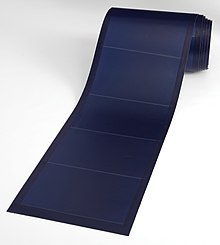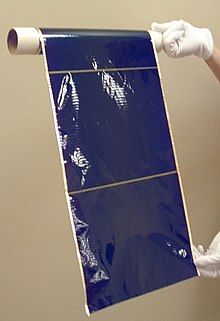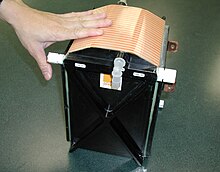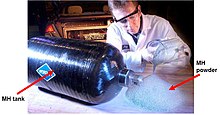| This article uses bare URLs, which are uninformative and vulnerable to link rot. Please consider converting them to full citations to ensure the article remains verifiable and maintains a consistent citation style. Several templates and tools are available to assist in formatting, such as reFill (documentation) and Citation bot (documentation). (September 2022) (Learn how and when to remove this message) |
| Company type | Public |
|---|---|
| Traded as | Nasdaq: ENER (2003–2012) |
| Industry | Alternative energy |
| Founded | 1960; 65 years ago (1960) |
| Founder | Stanford R. Ovshinsky |
| Defunct | 2012; 13 years ago (2012) |
| Fate | Bankruptcy |
| Headquarters | Auburn Hills, Michigan, United States |
Energy Conversion Devices, Inc. (ECD) was an American photovoltaics manufacturer of thin-film solar cells made of amorphous silicon used in flexible laminates and in building-integrated photovoltaics. The company was also a manufacturer of rechargeable batteries and other renewable energy related products. ECD was headquartered in Rochester Hills, Michigan.
Through its wholly owned Auburn Hills, Michigan, subsidiary United Solar Ovonic, LLC, better known as Uni-Solar, ECD was at one time the world's largest producer of flexible solar panels. Uni-Solar panels consisted of long rectangular strips with wiring at one end, which could be glued to any suitable supporting surface. They were widely used on flat roofs, motorhomes, semi-trailer cabs and similar roles.
On February 14, 2012, Energy Conversion Devices, Inc. and its subsidiaries, United Solar Ovonic LLC and Solar Integrated Technologies, Inc. filed for bankruptcy in the U.S. United States District Court for the Eastern District of Michigan.
Company
Energy Conversion Devices, Inc. (ECD), through its United Solar Ovonic (USO) subsidiary, was engaged in building-integrated and rooftop photovoltaics (PV). The Company manufactured, sold and installed thin-film solar laminates that converted sunlight to electrical energy.
The Company operated in two segments: United Solar Ovonic and Ovonic Materials. The Company's USO segment consisted of its wholly owned subsidiary, United Solar Ovonic LLC, which was engaged in manufacturing of PV laminates designed to be integrated directly with roofing materials. The Ovonic Materials segment invented, designed and developed materials and products based on ECD's materials science technology. ECD, through its subsidiaries, commercialized materials, products and production processes for the alternative energy generation (primarily solar energy), energy storage and information technology markets.
Ovonics (coined from "Ovshinsky" and "electronics") is a field of electronics that uses materials able to change from an electrically nonconducting state to a semiconducting state shown by glass of special composition upon application of a certain minimum voltage. The most important example is phase change memory.
Scientist-entrepreneur Stanford R. Ovshinsky pioneered the field and coined the term after he founded Energy Conversion Devices, Inc. (ECD) in 1960 to further his research in amorphous semiconductors. ECD Ovonics worked to create non-polluting, non-climate-changing energy sources.
Energy Conversion Devices, Inc. (ECD):
- Was a producer of flexible solar panels.
- Activity included NiMH batteries, solid-state hydrogen fuel storage, metal hydride fuel cells, and solar.
- Founder Stanford Ovshinsky was honored as "Hero for the planet" by Time magazine in 1999, and inducted into the U.S.-based Solar Energy Hall of Fame in 2005.
- ECD Ovonics stock was listed on the NASDAQ with symbol ENER in 2007 and on the Frankfurt Stock Exchange, before being delisted after filing for bankruptcy.
Company structure
ECD Ovonics was divided into three parts, and had full or partial ownership of several other companies.
- Energy generation
- United Solar Ovonic Corp (100% owned): flexible photovoltaic laminates producer
- Solar Integrated, Inc. (100% owned): Solar installations administration, system design, engineering, construction, operations and maintenance
- Ovonic Fuel Cell Company LLC (100% owned)
- Energy storage
- Information technology
United Solar Ovonic Corporation


The United Solar Ovonic Corporation was at one time the world's largest (2008) manufacturer of photovoltaic laminates. In the broader category of thin film solar cells, as of 2007 the company was the second-largest U.S. manufacturer, after First Solar. The solar cells are made of 11 triple junction amorphous silicon solar cells connected in series and have 11–13% in conversion efficiency. The laminate encapsulation material was durable ETFE, high light-transmissive polymer. The laminates were sold under the trademark "UNI-SOLAR".


Manufacturing and global headquarters were in Auburn Hills, Michigan. A second campus was constructed in Greenville, Michigan in 2007. Much of the production was sold to manufacturers and suppliers of building envelope elements, such as metal roofs (Rheinzink, Corus "Kalzip") or polymer roof membranes (Alwitra, Solar Integrated technologies). Flexible, thin-film solar PV products were also developed for space applications.
Solar Integrated, Inc.
Solar Integrated, Inc. was a wholly owned subsidiary of Energy Conversion Devices, Inc. and as an EPC contractor (Engineering, Procurement, Construction), Solar Integrated took responsibility for the whole supply chain from administration, system design and engineering to purchasing, construction, operations and maintenance of Uni-Solar products.
Ovonic batteries

Ovonic nickel–metal hydride (NiMH) batteries were used in the 1998 Chevrolet S-10 EV and the 1999 General Motors EV1, as well as many other hybrid vehicles in production today.

The battery was also used in an auto rickshaw concept vehicle made for Bajaj Auto, which burned hydrogen in an internal combustion engine. They made a report on it called "Clean Hydrogen Technology for 3-Wheel Transportation in India" and it stated that the performance was comparable with compressed natural gas (CNG) autos.
Patent encumbrance
Main article: Patent encumbrance of large automotive NiMH batteriesIn 1994, General Motors acquired a controlling interest in Ovonics's battery development and manufacturing, including patents controlling the manufacturing of large nickel metal hydride (NiMH) batteries.
On October 10, 2000, Texaco announced the purchase of General Motors' share in GM Ovonics, and Chevron announced its acquisition of Texaco six days later. In 2003, Texaco Ovonics Battery Systems was restructured into Cobasys, a 50/50 joint venture between Chevron and Energy Conversion Devices (ECD) Ovonics.
In addition to holding a 50% share of Cobasys, Chevron holds a 19.99% interest in ECD Ovonics. Chevron maintains veto power over any sale or licensing of Cobasys' NiMH technology. In addition, Chevron maintains the right to seize all of Cobasys' intellectual property rights in the event that ECD Ovonics does not fulfill its contractual obligations. On September 10, 2007, Chevron filed a legal claim that ECD Ovonics has not fulfilled its obligations. ECD Ovonics disputes this claim.
In her book, Plug-in Hybrids: The Cars that Will Recharge America, published in February 2007, Sherry Boschert argues that large-format NiMH batteries are commercially viable but that Cobasys refuses to sell or license them to small companies or individuals. Boschert reveals that Cobasys accepts only very large orders for these batteries. When Boschert conducted her research, major auto makers showed little interest in NiMH batteries. Since no other companies were capable of producing large orders, Cobasys was not manufacturing any NiMH batteries for automotive purposes.
In December 2006, Cobasys and General Motors announced that they had signed a contract under which Cobasys would provide NiMH batteries for the Saturn Aura hybrid sedan. Although announced, the car was later scrapped and Saturn has been shut down. In March 2007, General Motors announced that it would use Cobasys NiMH batteries in the 2008 Chevrolet Malibu hybrid as well. Cobasys remains unwilling to produce and sell NiMH batteries in smaller quantities to individuals interested in building or retrofitting their own plug-in hybrid electric vehicles (PHEVs). In 2009 Mercedes had planned to release an ML450 hybrid SUV in the United States, but Chevron, the parent company, pulled funding from Cobasys and the batteries were not delivered. On July 14, 2009 Cobasys was bought by SB LiMotive a joint venture of Samsung and Bosch before later being folded into Bosch itself. Although mistaken as owning the intellectual property to the large NiMH battery packs, according to CEO Tom Neslage they merely have an exclusive licensing deal with Chevron.

In February 2012, ECD sold its majority owned subsidiary, Ovonic Battery Company to BASF Corporation for the gross purchase price of $58 million in cash before transaction fees, minority participations, and working capital and other adjustments.
See also
References
- "Chapter 11 Restructuring « Uni-Solar".
- ^ "Energy Conversion Devices Inc (ENER) SPO". NASDAQ.com. Retrieved 2019-04-24.
- Helman, Christopher (8 April 2010). "Roofs for Rich Green People". Forbes. Archived from the original on 2014-04-30. Retrieved 17 May 2017.
- Hornblower, Margot (1999-02-22). "Heroes For The Planet: Design". Time. ISSN 0040-781X. Retrieved 2022-05-13.
- Energy Conversion Devices (ECD Ovonics) Core Businesses & Strategic Alliances. ECD Ovonics was a leader in the fields of alternative energy generation and storage, and advanced information technologies
- http://www.nrel.gov/pv/thin_film/docs/IEEE08off.pdf Paper from the U.S. National Renewable Energy Laboratory. Archived 2008-10-07 at the Wayback Machine
- "Solar Integrated: United Solar Announces NREL Measurement of World Record 12% Efficient Thin-Film Silicon Cell". solarintegrated.com. 2011-02-08. Archived from the original on 2011-06-18. Retrieved 2024-12-27.
- http://www.uni-solar.com/interior.asp?id=94 Unisolar list of strategic partners Archived October 5, 2007, at the Wayback Machine
- Beernink, Kevin (2007-02-01). "Lightweight, Flexible Solar Cells on Stainless Steel Foil and Polymer for Space and Stratospheric Applications". Proceedings of the 19th Space Photovoltaic Research and Technology Conference"; P. 54-66; NASA/CP-2007-214494.
- India Showcases Hydrogen Fuel Auto-Rickshaws
- Texaco To Acquire General Motor's Share of GM Ovonic Battery Joint Venture: Deal Reflects Technology's Potential For Broad Energy Applications Archived 2012-07-24 at archive.today. (Press release). Cobabsys, 2000-10-10. Retrieved on 2007-08-08.
- Miller, Joe (23 October 2000). "GM will sell its 60% stake in battery maker to Texaco". Automotive News.
- "Electric Vehicles UK".
- Chevron and Texaco Agree to $100 Billion Merger Creating Top-tier Integrated Energy Company Archived 2009-05-20 at the Portuguese Web Archive Texaco Investor Relations Archive, 2000-10-16. Retrieved on 2007-08-08.
- ChevronTexaco Corporation Announce Completion of Merger Archived 2009-05-20 at the Portuguese Web Archive. Texaco Investor Relations Archive, 2001-10-09. Retrieved on 2007-08-08.
- Roberson, J. (March 14, 2007) "Supplier Cobasys exploring more hybrid batteries" Detroit Free Press
- ECD Ovonics Definitive Proxy Statement Archived April 19, 2012, at the Wayback Machine of January 15, 2003
- ^ ECD Ovonics Amended General Statement of Beneficial Ownership Archived July 29, 2009, at the Wayback Machine of December 2, 2004
- ECD Ovonics 10-Q Quarterly Report Archived May 24, 2009, at the Wayback Machine for the period ending September 30, 2007
- Boschert, S. (2007) Plug-in Hybrids: The Cars that Will Recharge America (Gabriola Island, BC: New Society Publishers) ISBN 978-0-86571-571-4
- Abuelsamid, S. (December 6, 2006) "Cobasys providing NiMH batteries for Saturn Aura hybrid" Autobloggreen.com
- "InformationWeek, serving the information needs of the Business Technology Community". Archived from the original on 2010-01-03. Retrieved 2010-02-07.
- "Samsung-Bosch battery venture buys U.S. Cobasys". Reuters. 14 July 2009.
- "Cobasys CEO Defends His Battery Company | Hybrid Cars". Archived from the original on 2008-08-11.
- "Energy Conversion Devices Files Chapter 11; Seeks Sale of Businesses « Uni-Solar".
External links
- Scientific American Frontiers on PBS.org: Meet the Ovshinskys Archived 2015-10-12 at the Wayback Machine
- NPR: Entrepreneur Retools Combustion Engine
- Lemelson-MIT Inventor of the Week: Amorphous Semiconductor Materials
- Time: Heroes for the Planet
- US Patent No. 6,969,567 - Multi-cell battery Archived 2016-01-05 at the Wayback Machine


